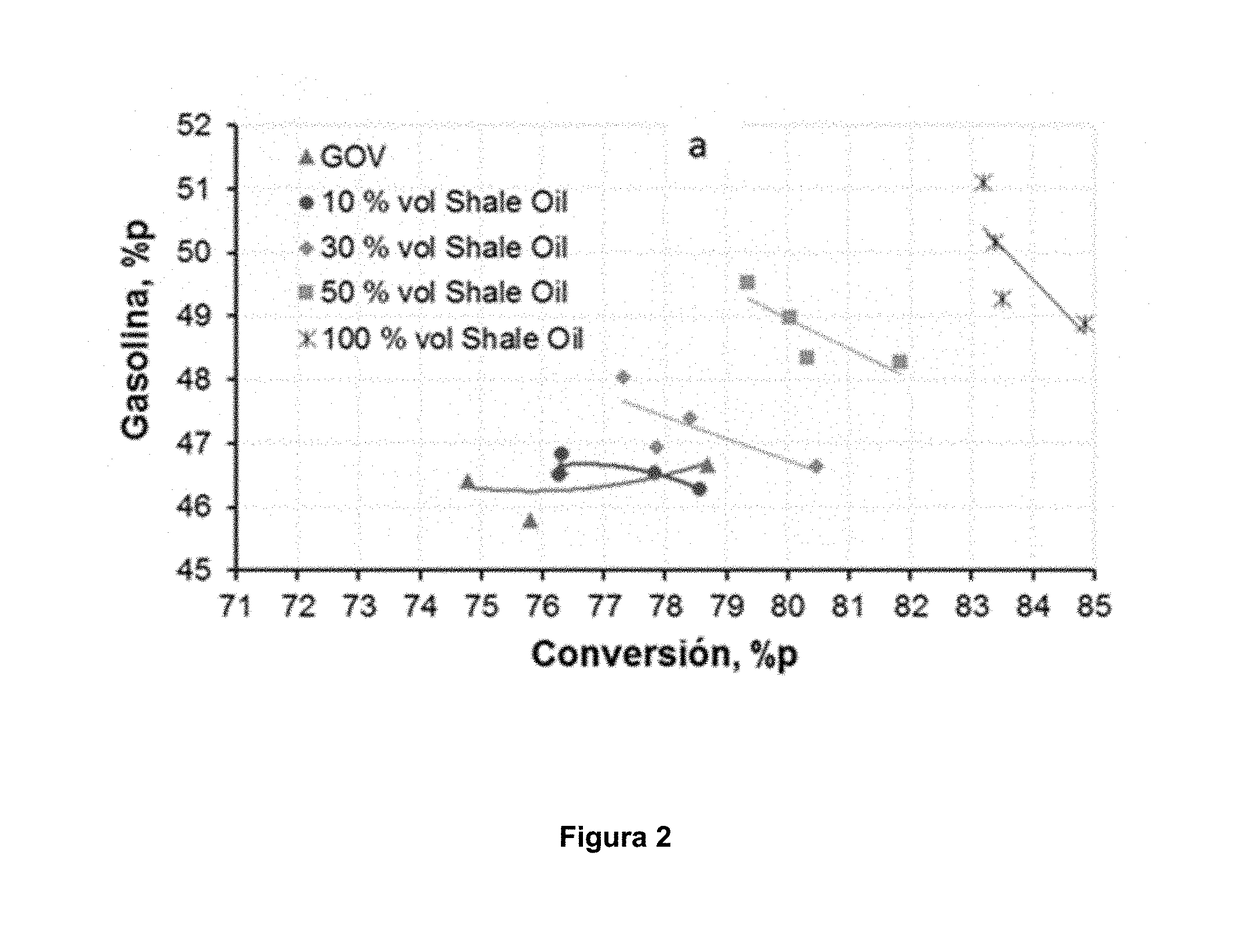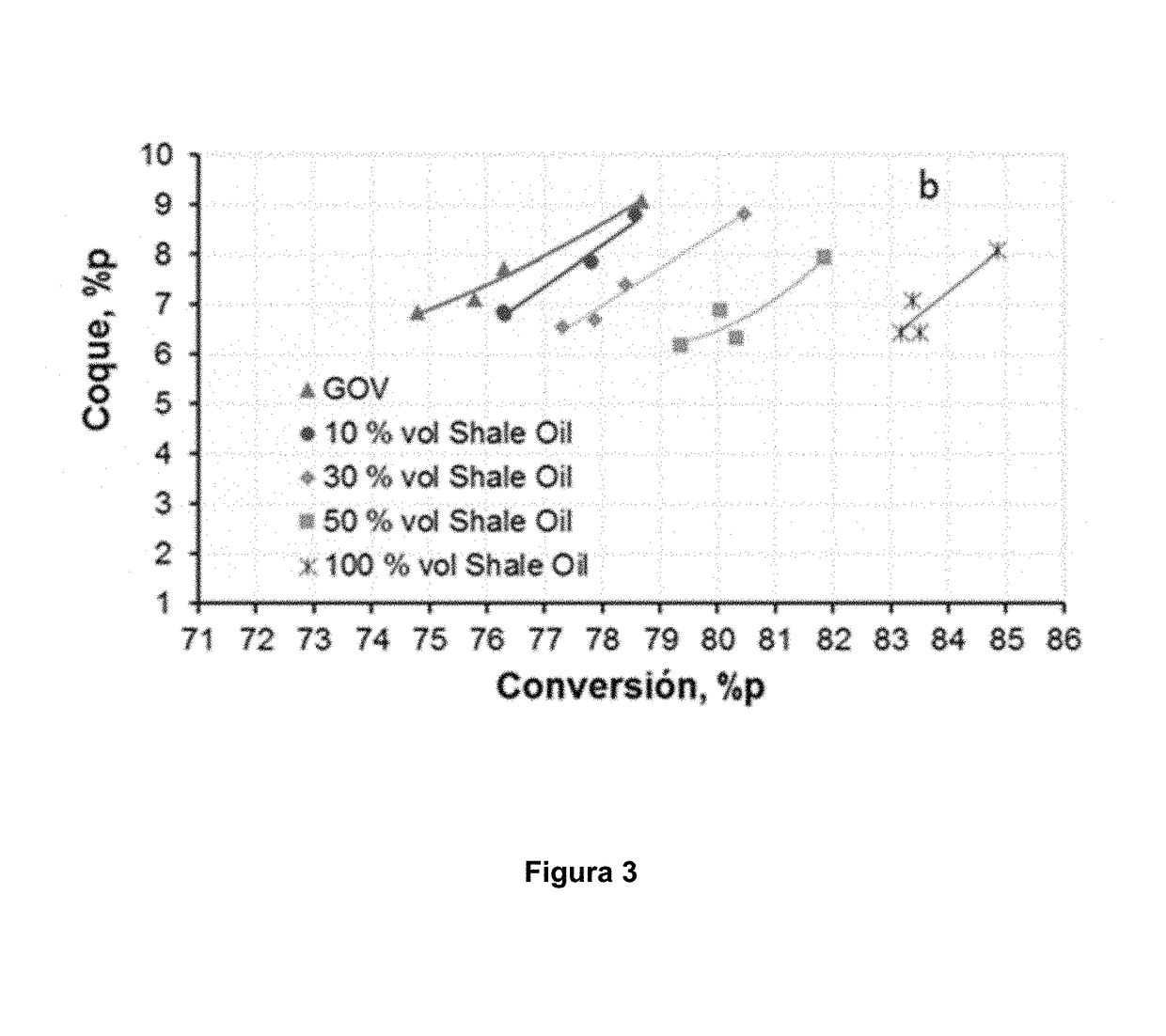Process and zeolitic catalyst for the catalytic cracking of unconventional light crude oil type shale/tight oil and its blends with vacuum gas oil
a technology of zeolitic catalyst and light crude oil, which is applied in the direction of catalytic cracking, hydrocarbon oil treatment, molecular sieve catalyst, etc., can solve the problems of affecting the yield and catalytic performance of conventional fcc catalyst, affecting the thermal balance of fcc units, and drastically reducing coke yield
- Summary
- Abstract
- Description
- Claims
- Application Information
AI Technical Summary
Benefits of technology
Problems solved by technology
Method used
Image
Examples
example 1
[0083]A catalyst (designated CAT-1) was prepared using 38% of an Ultrastable Y Faujasite Zeolite (USY) containing from 8 to 8.5% by weight of rare earth oxide (RE2O3) and maximum 1.2% by weight of Na2O. Catalyst CAT-1 also contains 2.0% by weight of ZSM-5 zeolite. As a binder, 15% by weight of alumina from boehmite, formic acid and water were used; the aforementioned boehmite was obtained according to the method described in the Mexican patent MX 245842. In the preparation, 10% by weight of silicon oxide from colloidal silica AS-40 and kaolin were also used. With these materials a suspension with a 30% solids content was calculated.
[0084]In a container containing distilled water, each component was added and mixed at a stirring speed of 1000-4000 rpm for 15 minutes until all the components were integrated and a complete homogenization was achieved in the mixture. The material obtained was dried at a temperature between 50-200° C., preferably between 110-180° C. for 6 to 8 hours. The...
example 2
[0085]For the catalyst (named CAT-2) a composition of 35% of Ultrastable Y (USY) Faujasite zeolite was considered, containing 8 to 8.5% by weight of rare earth oxide (RE2O3) and maximum 1.2% by weight of Na2O. Catalyst also contains 2.0 wt% zeolite ZSM-5. As a binder, 1.5% by weight of an alumina from aluminum chlorohydrate, 13.5% by weight of alumina from boehmite, formic acid and water were used; the aforementioned boehmite was obtained according to the method described in the Mexican patent registration MX 245842. The catalyst CAT-2 also contains 10% by weight of silicon oxide from colloidal silica AS-40 and kaolin. With these materials and conditions, a suspension with 30% solids was calculated. This catalyst was prepared and heat-treated following the protocols described in Example 1.
example 3
[0086]The catalyst CAT-1 described in example 1 was deactivated at a temperature of 816° C. for 5 hours within an ambient of 100% water vapor, according to the following procedure:
[0087]The catalyst is introduced into a quartz tubular reactor provided with a porous plate of the same material. An upflow nitrogen stream is connected. The flow of nitrogen gas is set at a rate of 100 ml / min and heating is started from room temperature to 816° C., at a heating rate of 3-5° C. / min. Upon reaching the temperature of 816° C., the nitrogen flow is slowly closed and a 100% steam is introduced. These conditions of steam and temperature are maintained for 5 hours. At the end of the period, the steam flow is suspended, changed for nitrogen and cooled.
PUM
| Property | Measurement | Unit |
|---|---|---|
| Temperature | aaaaa | aaaaa |
| Temperature | aaaaa | aaaaa |
| Temperature | aaaaa | aaaaa |
Abstract
Description
Claims
Application Information
 Login to View More
Login to View More - R&D
- Intellectual Property
- Life Sciences
- Materials
- Tech Scout
- Unparalleled Data Quality
- Higher Quality Content
- 60% Fewer Hallucinations
Browse by: Latest US Patents, China's latest patents, Technical Efficacy Thesaurus, Application Domain, Technology Topic, Popular Technical Reports.
© 2025 PatSnap. All rights reserved.Legal|Privacy policy|Modern Slavery Act Transparency Statement|Sitemap|About US| Contact US: help@patsnap.com



